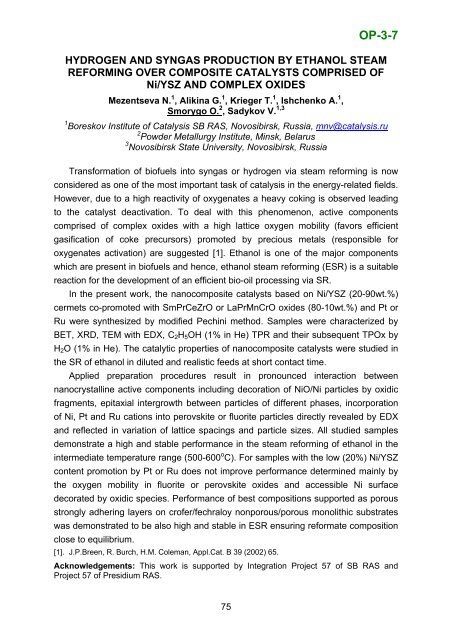Boreskov Institute of Catalysis SB RAS, Novosibirsk, Russia
Boreskov Institute of Catalysis SB RAS, Novosibirsk, Russia
Boreskov Institute of Catalysis SB RAS, Novosibirsk, Russia
- No tags were found...
Create successful ePaper yourself
Turn your PDF publications into a flip-book with our unique Google optimized e-Paper software.
OP-3-7HYDROGEN AND SYNGAS PRODUCTION BY ETHANOL STEAMREFORMING OVER COMPOSITE CATALYSTS COMPRISED OFNi/YSZ AND COMPLEX OXIDESMezentseva N. 1 , Alikina G. 1 , Krieger T. 1 , Ishchenko A. 1 ,Smorygo O. 2 , Sadykov V. 1,31 <strong>Boreskov</strong> <strong>Institute</strong> <strong>of</strong> <strong>Catalysis</strong> <strong>SB</strong> <strong>RAS</strong>, <strong>Novosibirsk</strong>, <strong>Russia</strong>, mnv@catalysis.ru2 Powder Metallurgy <strong>Institute</strong>, Minsk, Belarus3 <strong>Novosibirsk</strong> State University, <strong>Novosibirsk</strong>, <strong>Russia</strong>Transformation <strong>of</strong> bi<strong>of</strong>uels into syngas or hydrogen via steam reforming is nowconsidered as one <strong>of</strong> the most important task <strong>of</strong> catalysis in the energy-related fields.However, due to a high reactivity <strong>of</strong> oxygenates a heavy coking is observed leadingto the catalyst deactivation. To deal with this phenomenon, active componentscomprised <strong>of</strong> complex oxides with a high lattice oxygen mobility (favors efficientgasification <strong>of</strong> coke precursors) promoted by precious metals (responsible foroxygenates activation) are suggested [1]. Ethanol is one <strong>of</strong> the major componentswhich are present in bi<strong>of</strong>uels and hence, ethanol steam reforming (ESR) is a suitablereaction for the development <strong>of</strong> an efficient bio-oil processing via SR.In the present work, the nanocomposite catalysts based on Ni/YSZ (20-90wt.%)cermets co-promoted with SmPrCeZrO or LaPrMnCrO oxides (80-10wt.%) and Pt orRu were synthesized by modified Pechini method. Samples were characterized byBET, XRD, TEM with EDX, C 2 H 5 OH (1% in He) TPR and their subsequent TPOx byH 2 O (1% in He). The catalytic properties <strong>of</strong> nanocomposite catalysts were studied inthe SR <strong>of</strong> ethanol in diluted and realistic feeds at short contact time.Applied preparation procedures result in pronounced interaction betweennanocrystalline active components including decoration <strong>of</strong> NiO/Ni particles by oxidicfragments, epitaxial intergrowth between particles <strong>of</strong> different phases, incorporation<strong>of</strong> Ni, Pt and Ru cations into perovskite or fluorite particles directly revealed by EDXand reflected in variation <strong>of</strong> lattice spacings and particle sizes. All studied samplesdemonstrate a high and stable performance in the steam reforming <strong>of</strong> ethanol in theintermediate temperature range (500-600 o C). For samples with the low (20%) Ni/YSZcontent promotion by Pt or Ru does not improve performance determined mainly bythe oxygen mobility in fluorite or perovskite oxides and accessible Ni surfacedecorated by oxidic species. Performance <strong>of</strong> best compositions supported as porousstrongly adhering layers on cr<strong>of</strong>er/fechraloy nonporous/porous monolithic substrateswas demonstrated to be also high and stable in ESR ensuring reformate compositionclose to equilibrium.[1]. J.P.Breen, R. Burch, H.M. Coleman, Appl.Cat. B 39 (2002) 65.Acknowledgements: This work is supported by Integration Project 57 <strong>of</strong> <strong>SB</strong> <strong>RAS</strong> andProject 57 <strong>of</strong> Presidium <strong>RAS</strong>.75
















